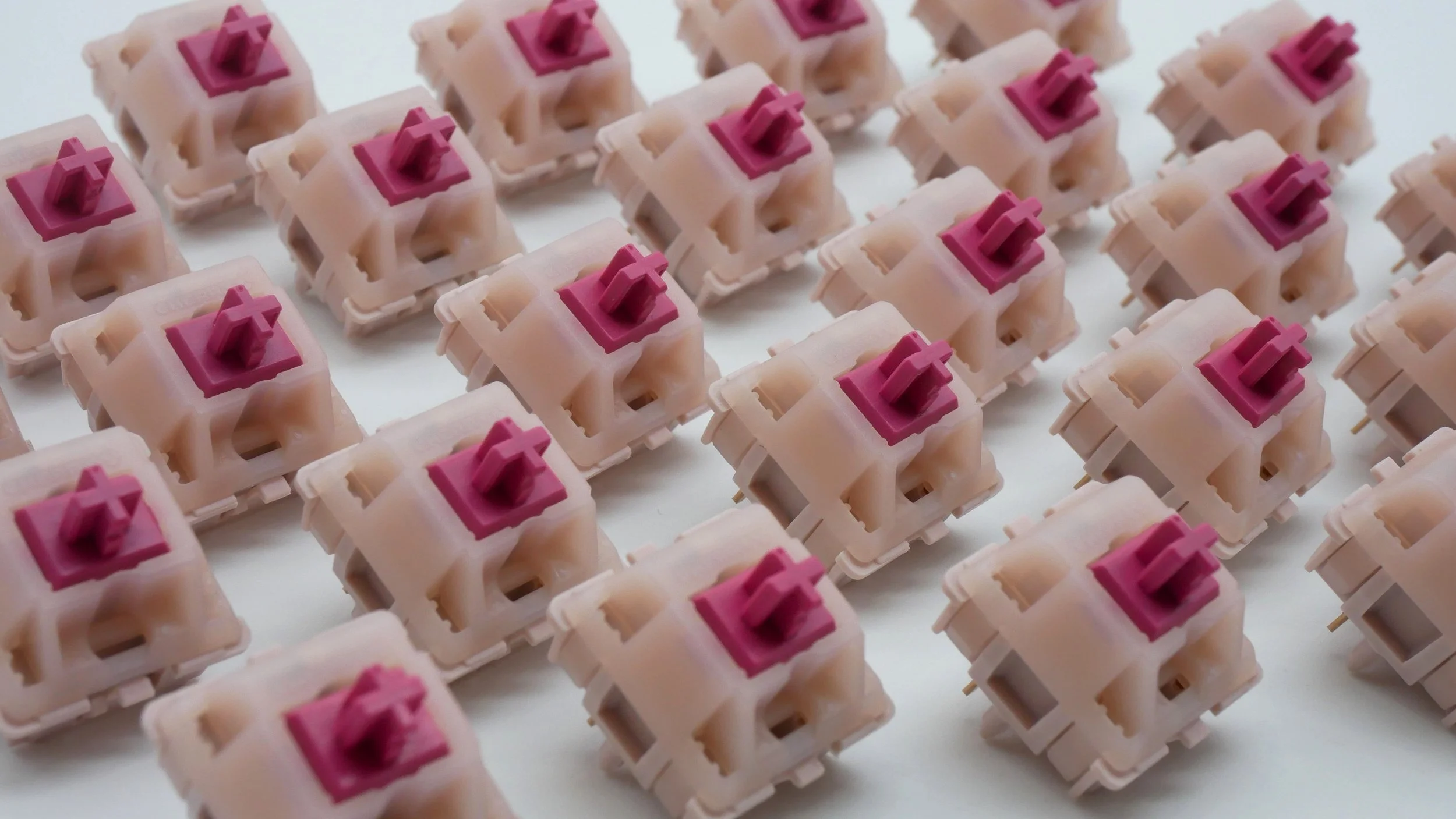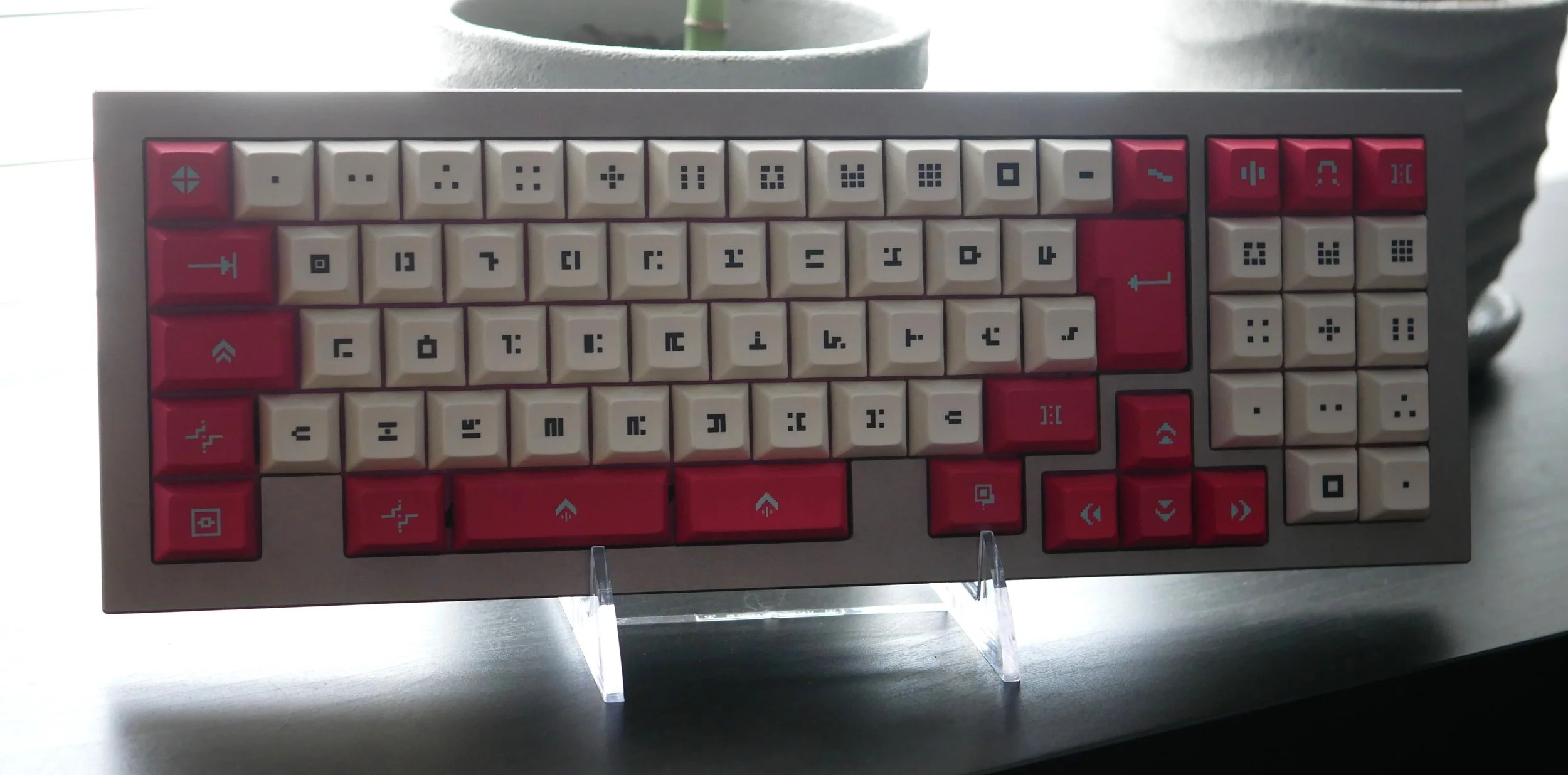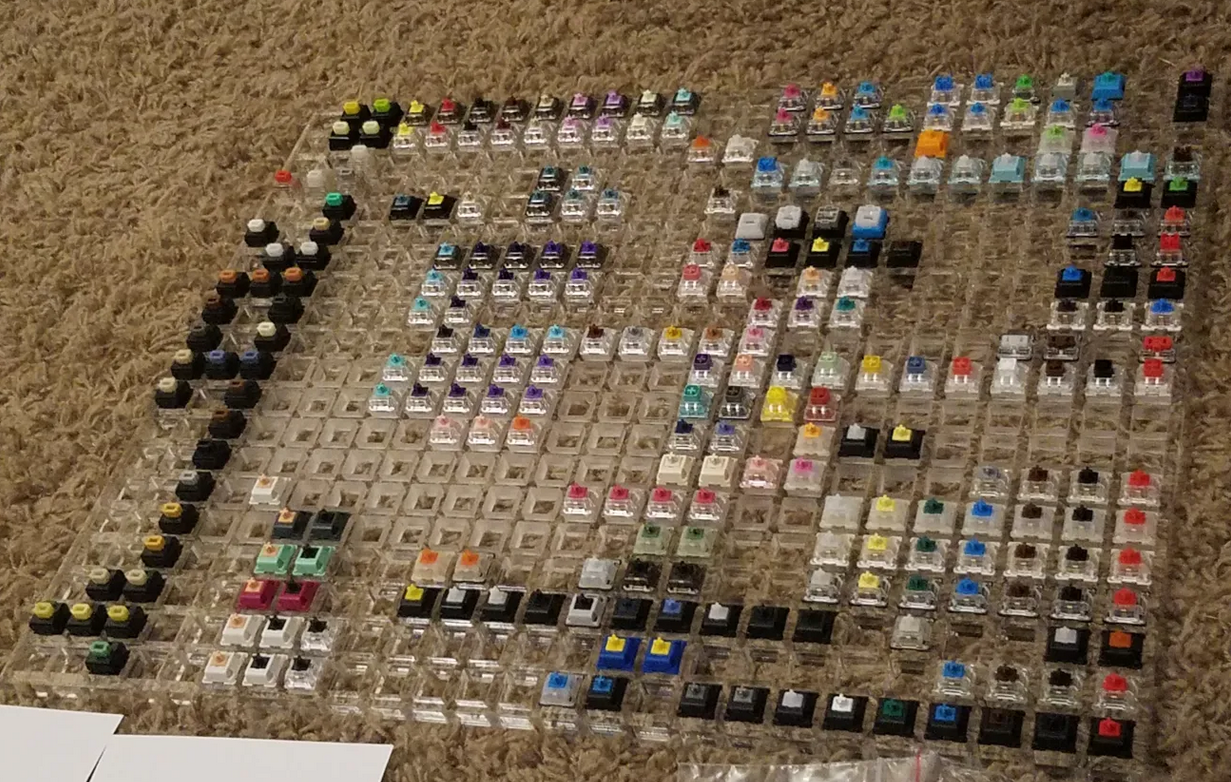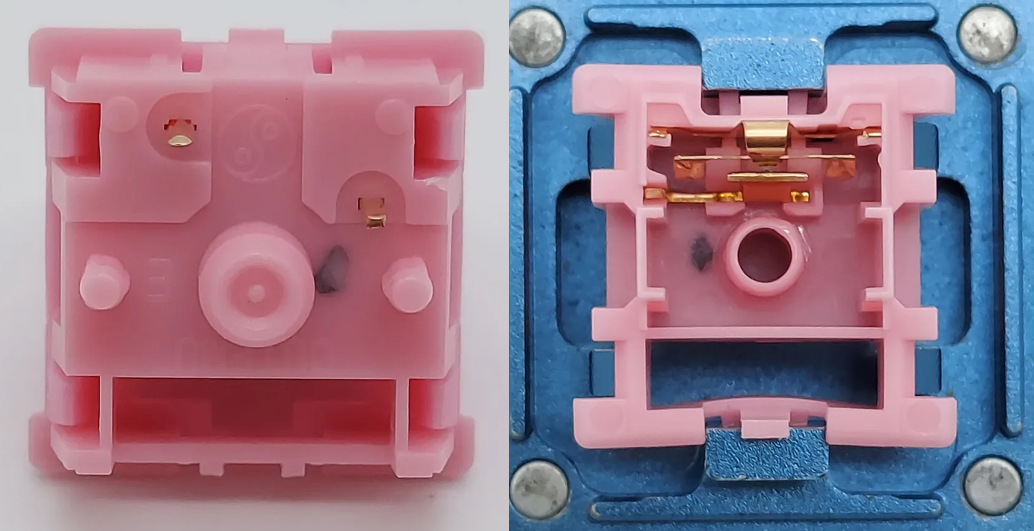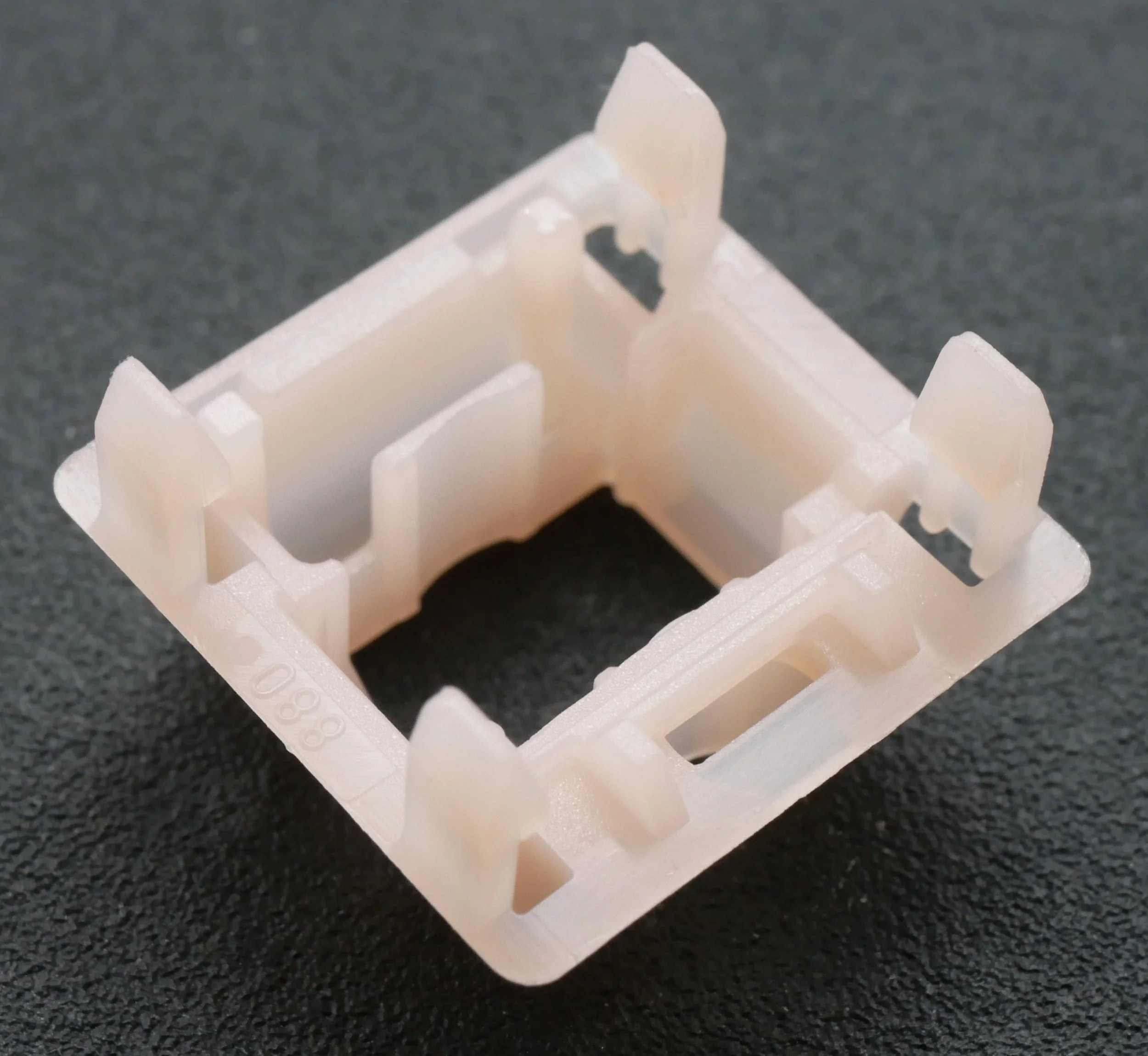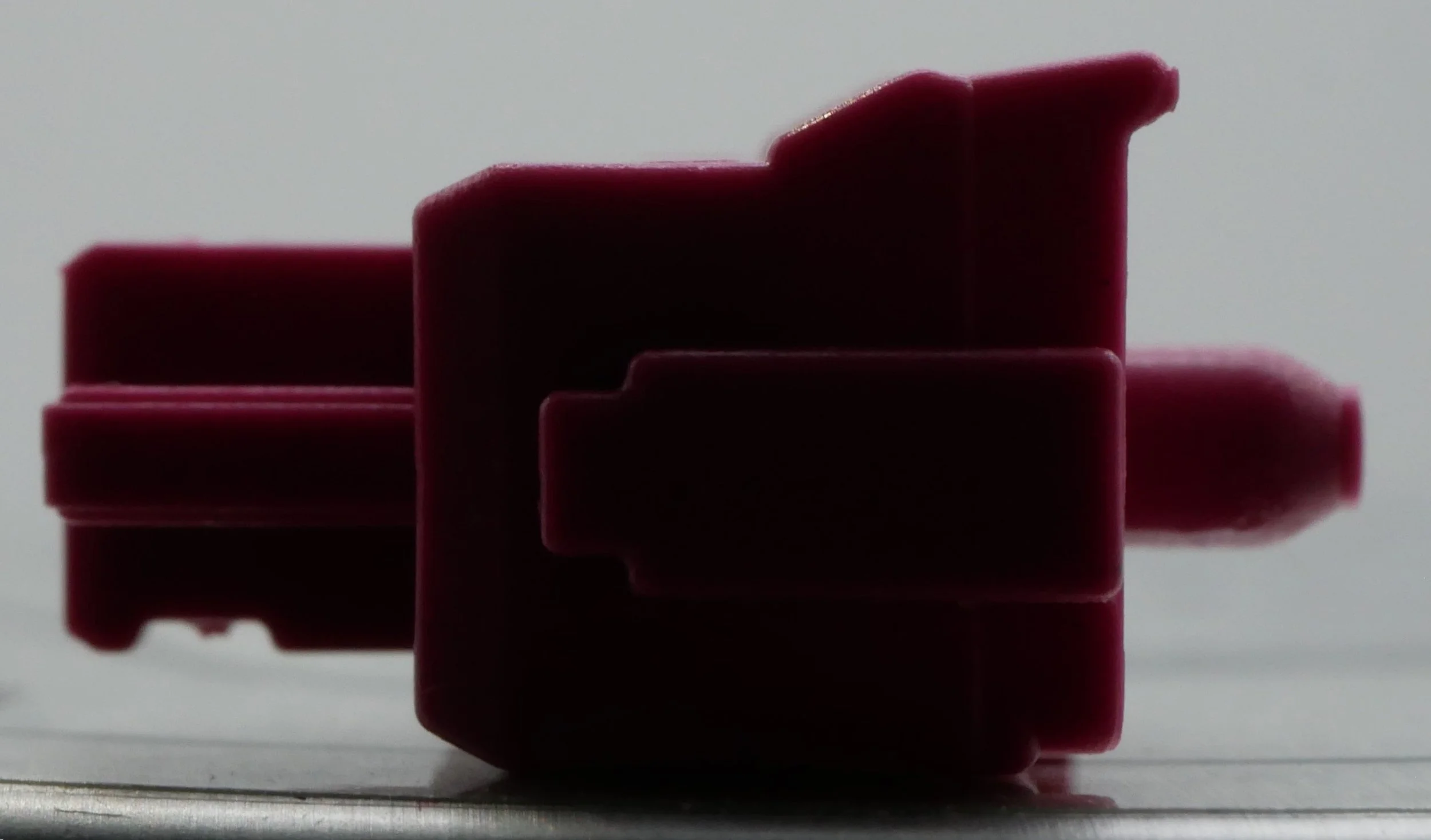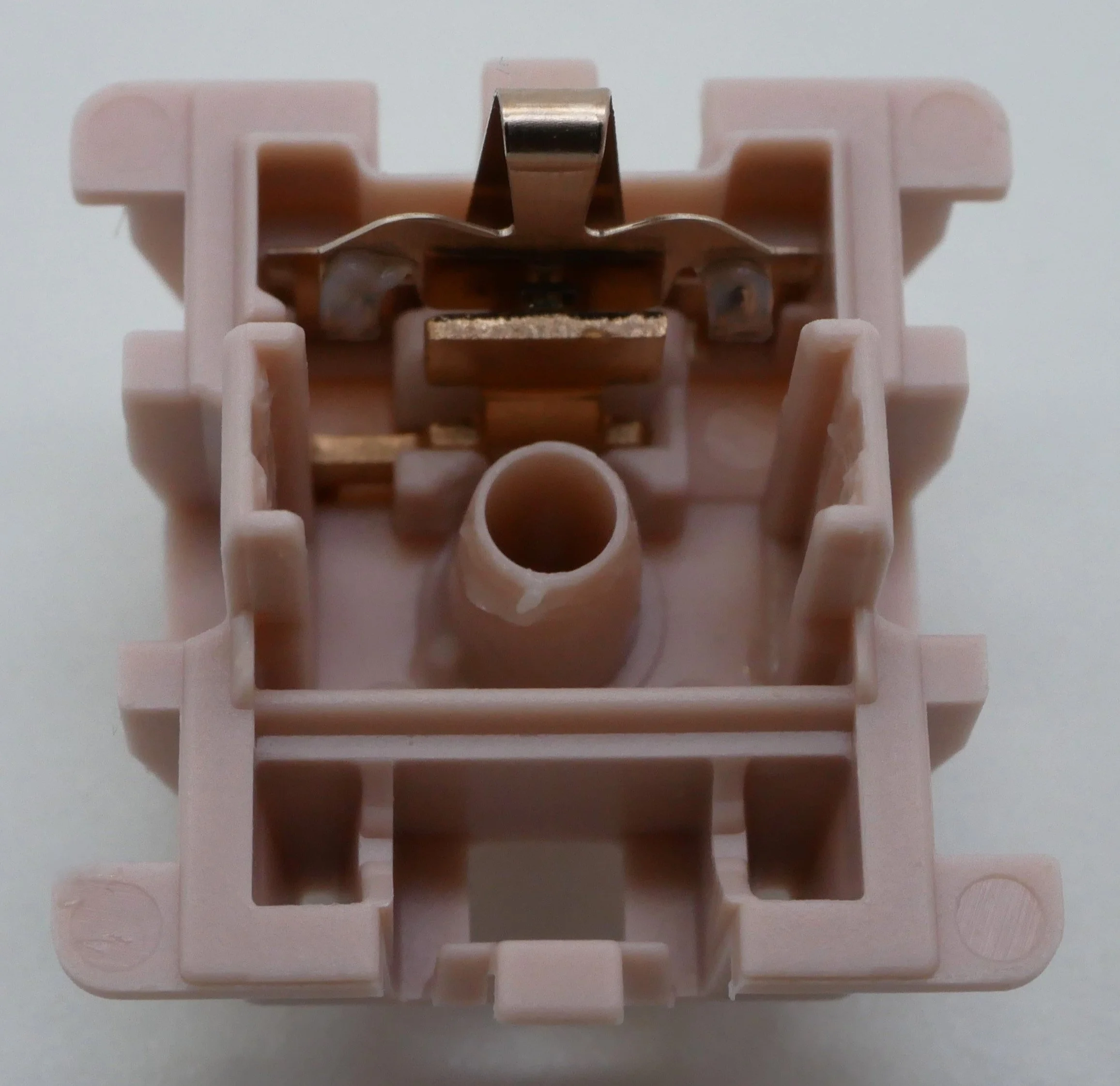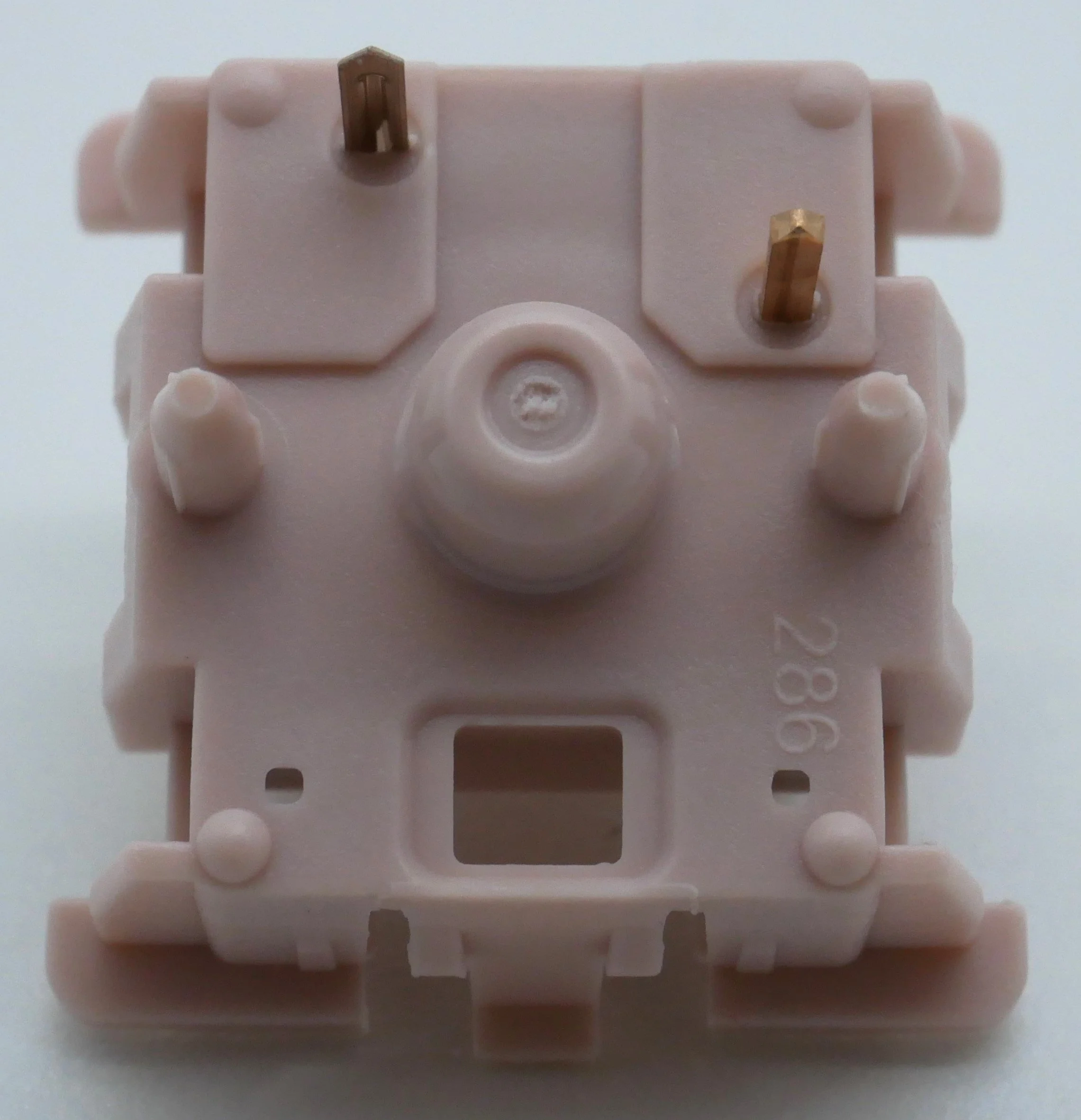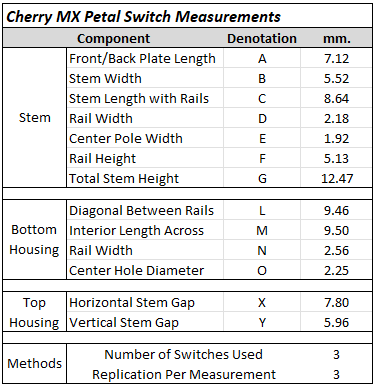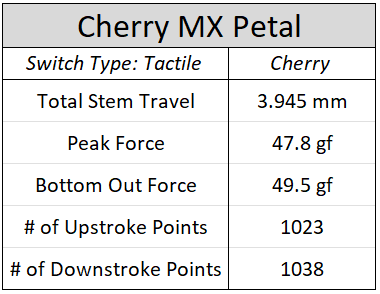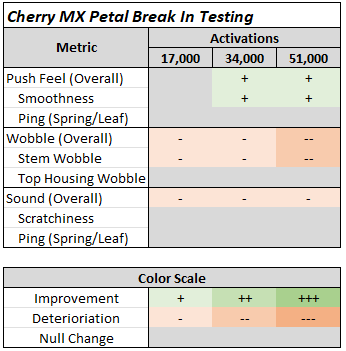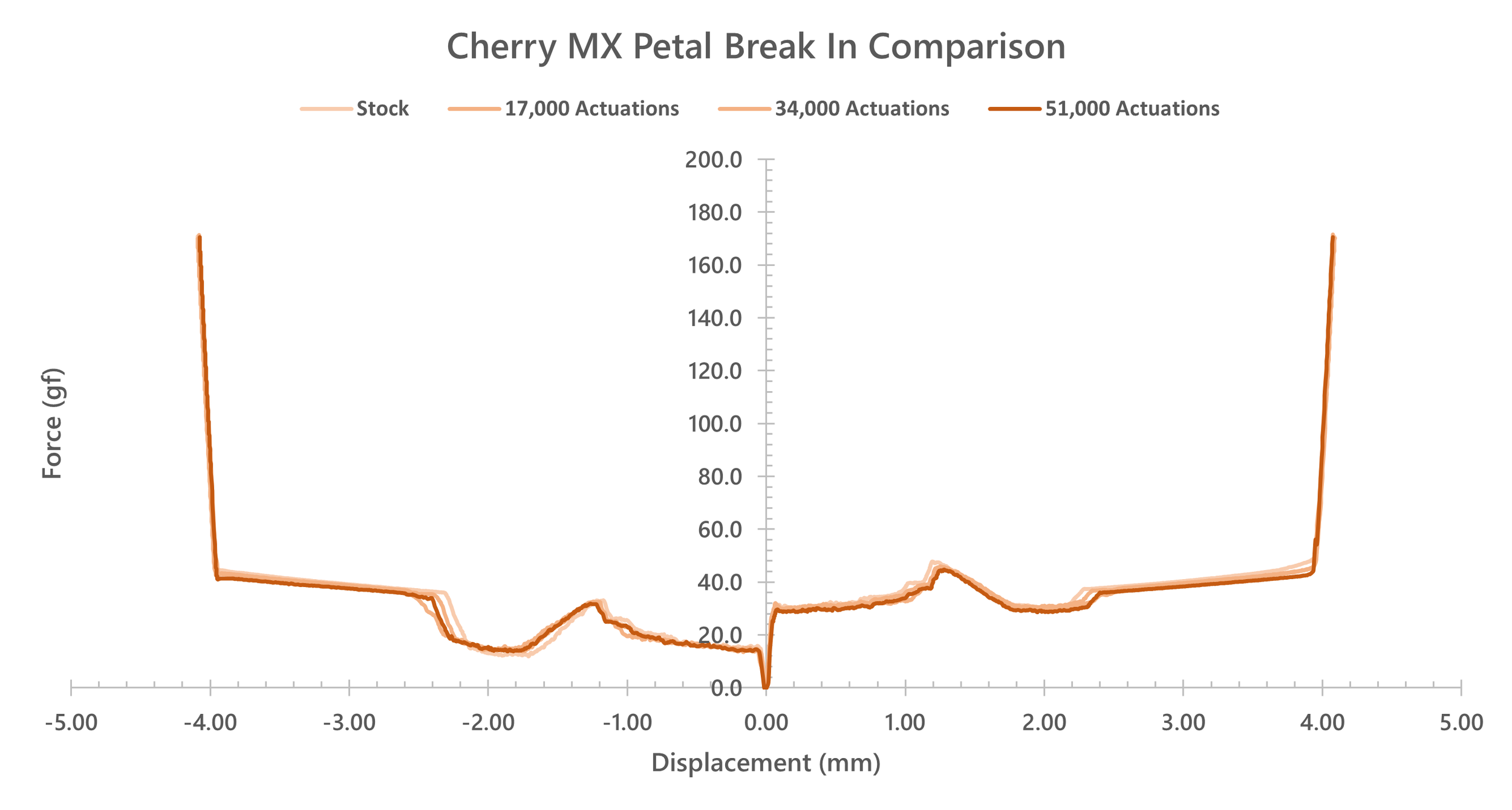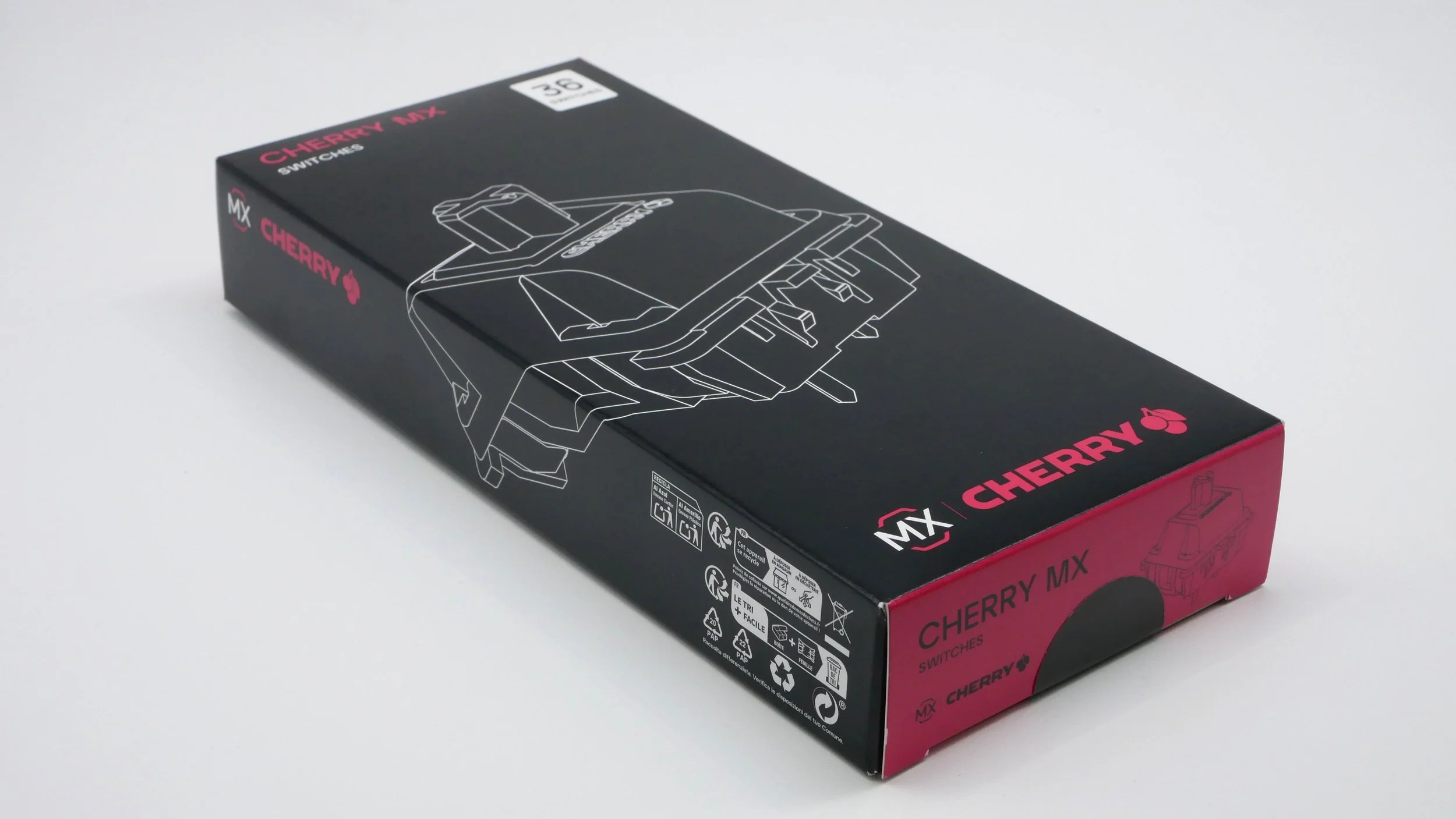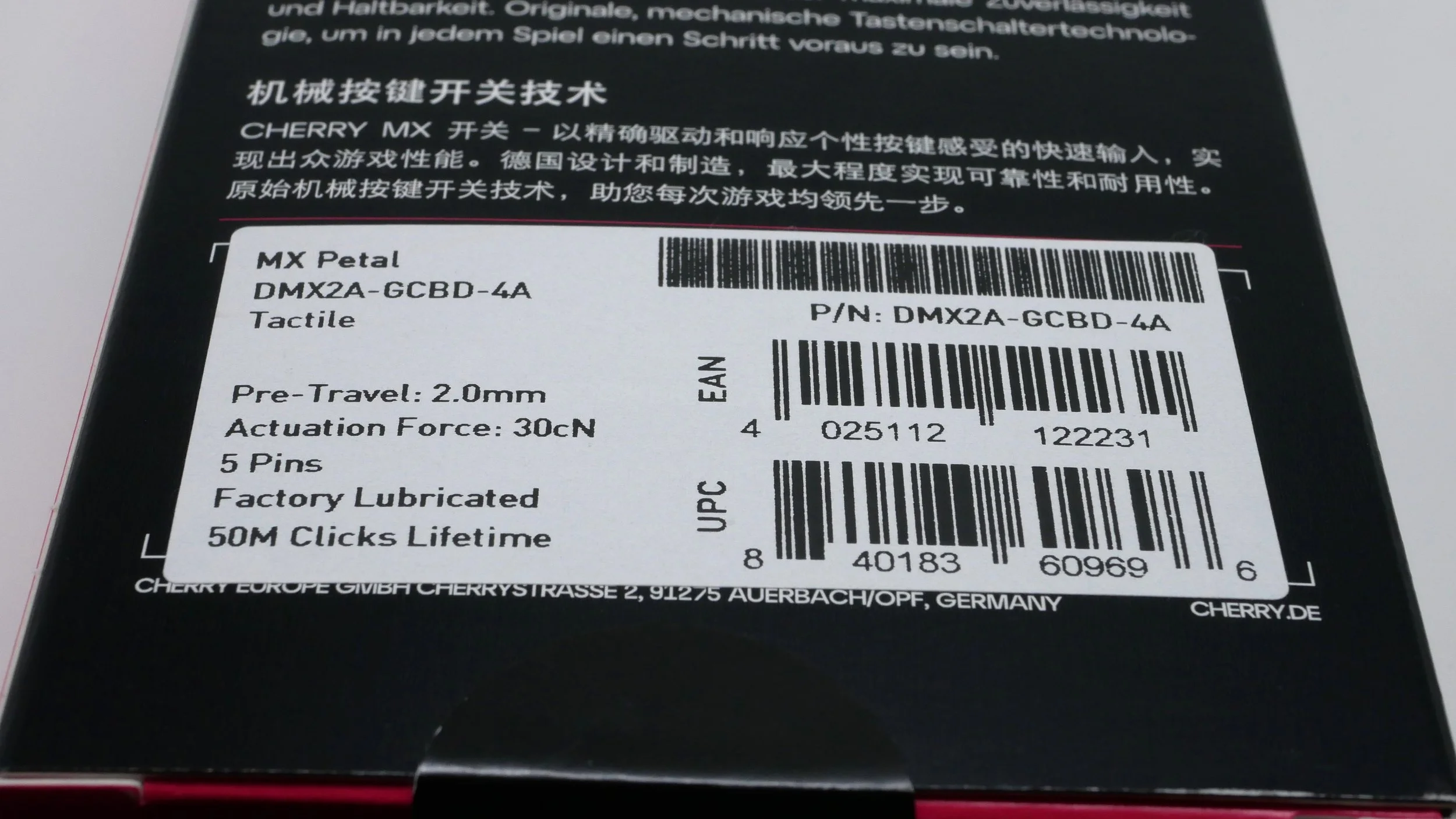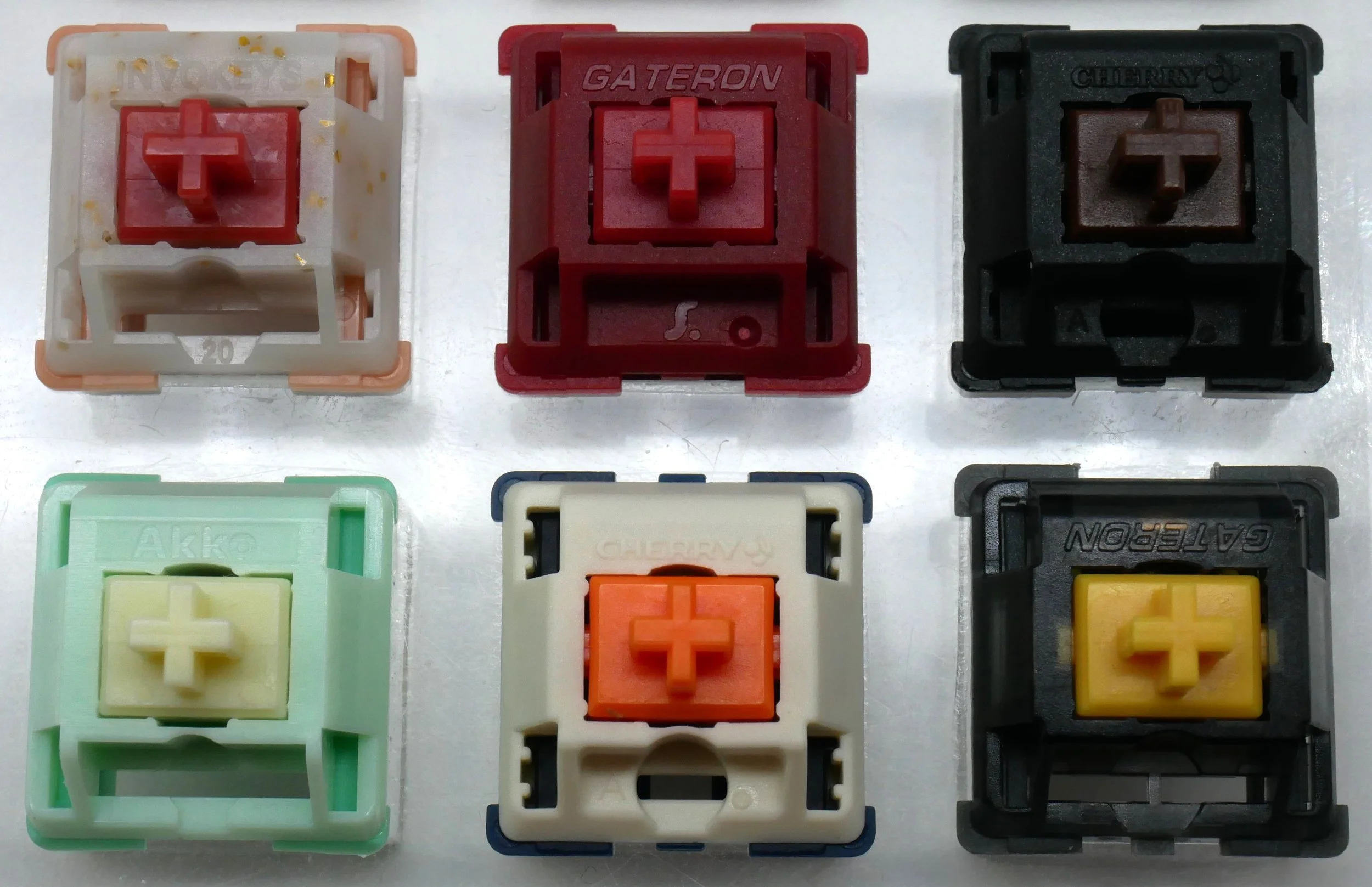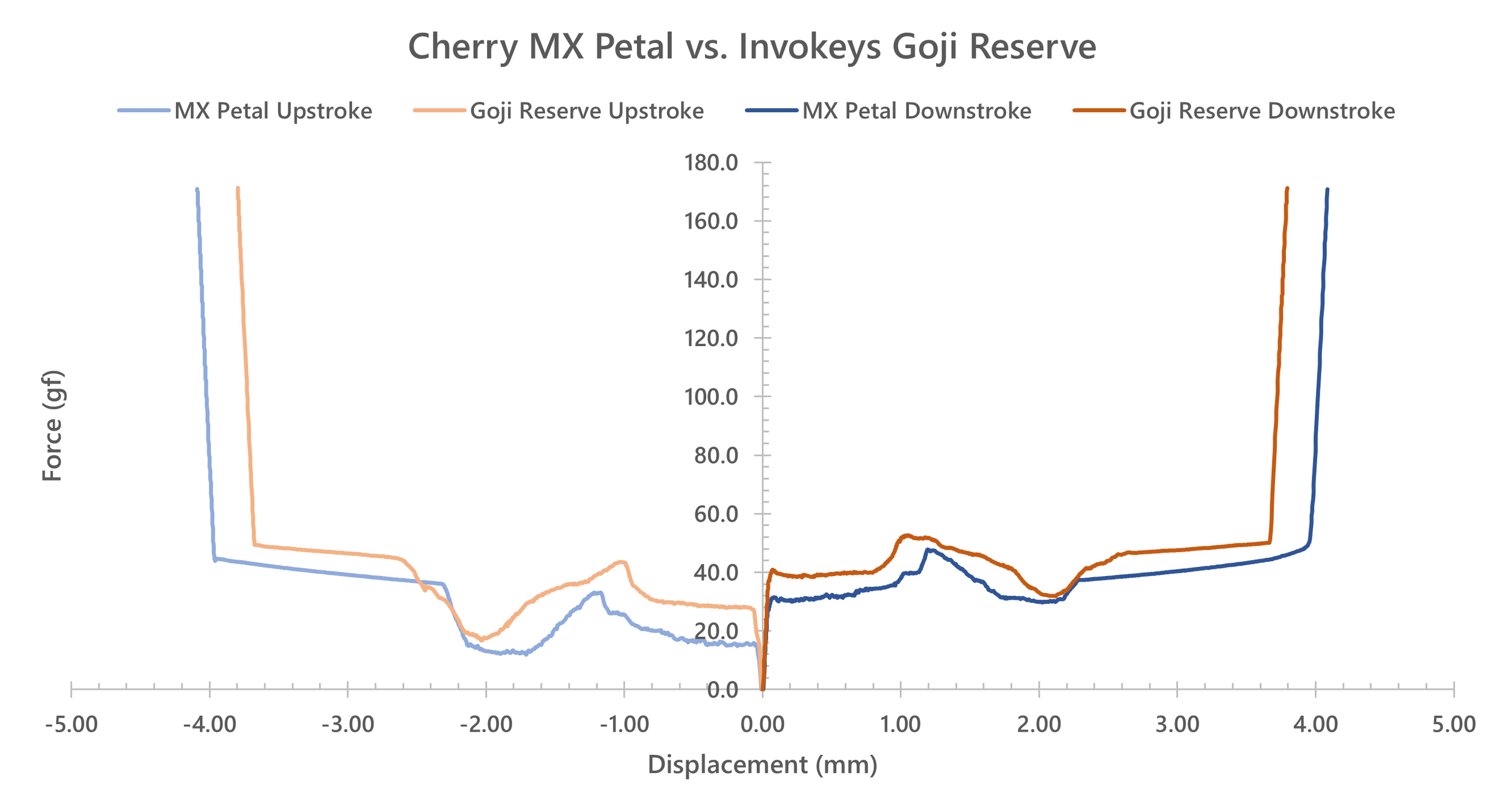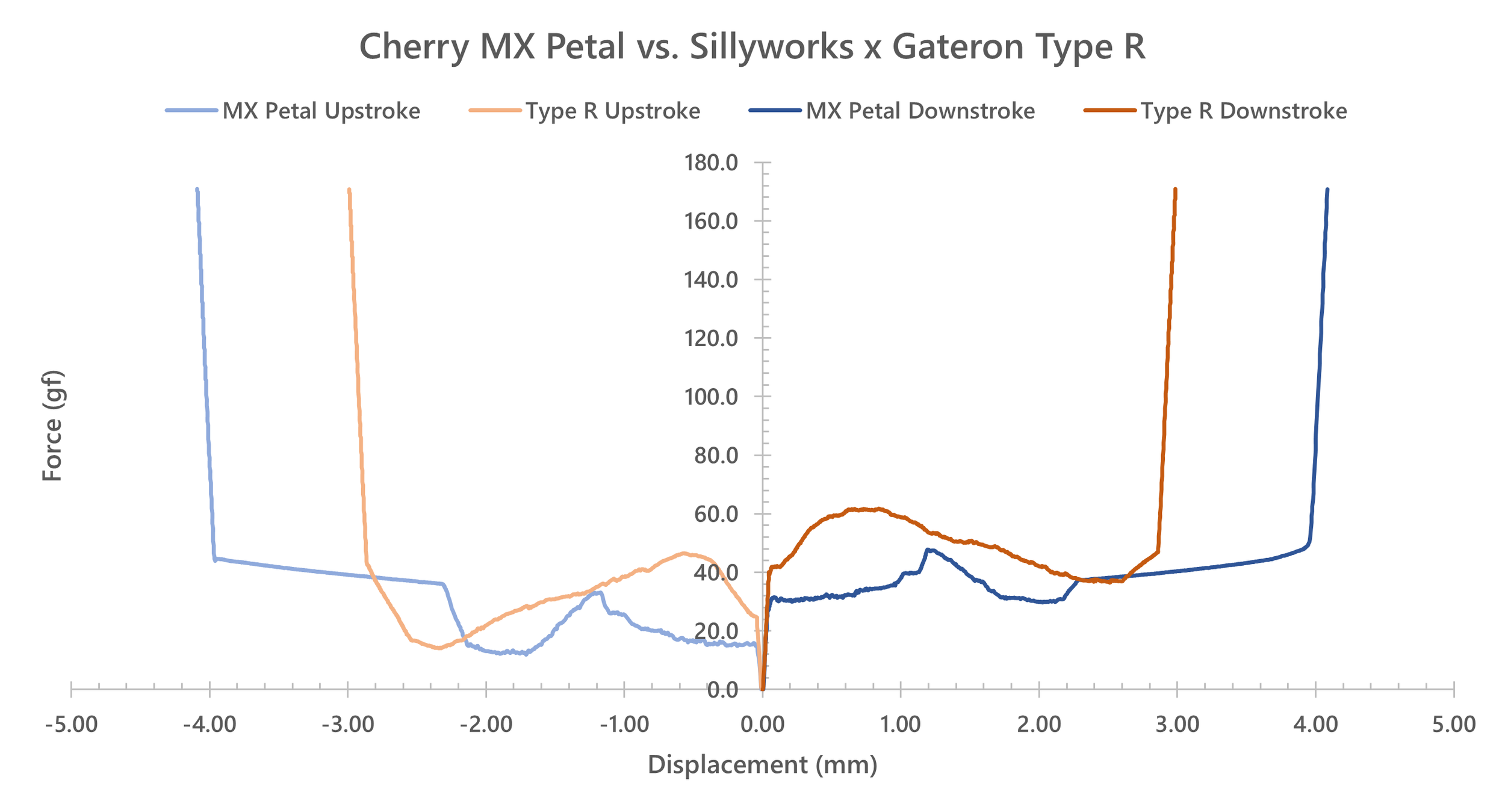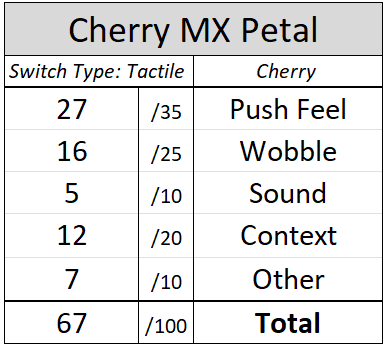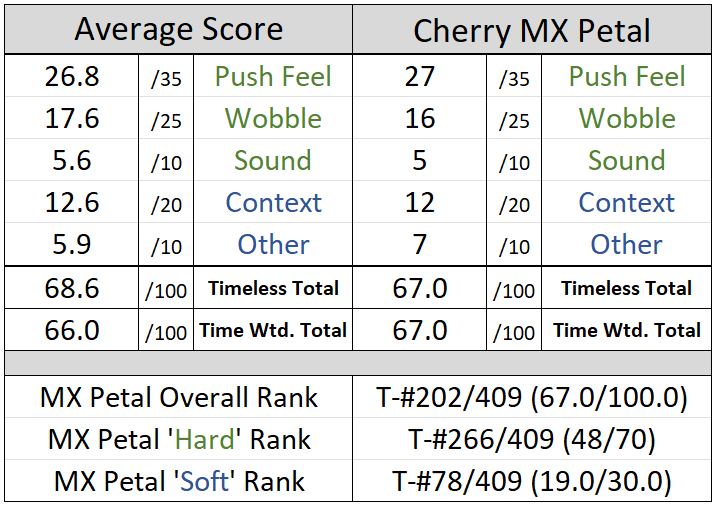Cherry MX Petal Switch Review
Note: In order to keep things as fully transparent as possible, I want to inform readers here that I was sent these switches by Cherry without any prompting or request whatsoever. As well, they made no attempt to ask me to review them, either. With this in mind, this review was conducted entirely of my own will and volition and without any notice nor support from Cherry. They did not receive an advanced copy of this review, editorial notes, nor in any way, shape, or form affected this review. All opinions here, as long winded as they may be, are expressly mine and mine alone.
Since the review of the Invokeys Goji Reserves was posted, my life has been kind of tumbling through what feels like a laundry spin cycle of unexpected upturns, downturns, and every-which-way turns. While I haven’t had anything incredibly drastic happen in any particular direction, the unpredictability of it all has kept me quite occupied and feeling as if I’ve not had much time to focus on any one thing in particular. Keyboards and switches have felt this lack of focus, especially. While the volunteering for the bird banding operation at BSBO is over for the season and I now should be able to get a sizable portion of my weekends that I was spending on that back to work on keyboard stuff, oh man do I have a lot of stuff piled up for me to work through. I’ve got no less than 200 new switches to catalogue and measure for the collection yet, an entire short article on new manufacturers that I have yet to finish up, and also that whole article on quantifying tactility that I’ve mentioned way too many times over the past year. No, those of you who attended Keycon and saw my talk about such, I’ve not forgotten about this responsibility or my promise, life has just changed a lot in the past few months. And that’s just the short list of things that I feel I need to get to doing – that’s not even all of the fun topics, articles, and content ideas that I would like to accomplish in writing at some point in time in that vague, far off thing called the ‘future’. Characterizing the last few weeks as completely useless on my behalf, though, would be a tad bit uncharitable as I have at least done one thing keyboard community related – I’ve reorganized my artisan collection. Yeah, yeah, I get that this is a switch reviewing website, but I do have that other small collection that has been steadily growing in the background alongside the switches over the years and it does feel a bit rewarding finally laying them all out there in a brand new 10 x 10 box. These other little colorful pieces of plastic are also some of the things that I would like to write about at some point in time, whenever I get through all of my switch work that is. So if you’ll allow me to end this introduction on a bit more of a positive note, allow me to wander a little bit into one of my other forays into the keyboard community and flex this new view from my desk:
Figure 1: I really like spending all of my money on funny colored plastic, regardless of what form it comes in.
Switch Background
Unfortunately with everything being so hectic over here the last few weeks, I’ve honestly had very little time to prepare for this review and the background section – so much so in fact that I’m already writing it a lot closer to my normal posting deadline than I’d feel comfortable with on any given week. Had I gotten to working on this earlier, both of these feelings could have very well been remedied by asking the Cherry C Lab team, the ones who designed these and other recent, more custom community focused Cherry switch releases, a bit about their switches as they’ve directly offered to answer questions should I have any come up. (Perhaps I should just try and get one of them to sit down for an interview article of sorts at some point…) Irrespective of these journalistic shortcomings on my behalf, though, I am a bit saved by the fact that these are the newest of the new Cherry switches, a background which I already briefly covered barely a month ago in the review of the Cherry MX Honey silent tactiles. It’s not like there’s been that much more background or newly unfolding stories surrounding Cherry for me to get into here. While I would normally take this lack of direct historical background and use it as a justification to meander into a broader scale contextual background about other light tactile switches as those seem to be gaining in popularity recently, with having just reviewed the Goji Reserves, having once again gone on about the Blueberry Chiffons, and with me actively making plans to do content on some other new light tactiles such as the Greetech OG switch re-releases, that well also feels like its drying up a bit too. Grasping for straws, the only real, tangible thing that I could glean from the Cherry MX Petal switches to build a background section around is… that they’re pink.
Figure 2: Look, we all know they messed up in not calling these switches Cherry MX Cherries, but there's always next switch release to make things right.
Pink colored mechanical keyboard switches and I go way, way back. And yet despite being a reviewer who already shares way too many thoughts straight out of their own head, I’ve surprisingly not written all that much about my specific fondness for and many personal connections to pink switches that seemingly get passed up by everyone else. For one, I don’t even think I’ve ever formally stated my bias here that I’ve mentioned a few times over in the various Discord serves I frequent in that I swear that pink switches, on average, just tend to be better. There’s no reality to that claim, nor factual basis for me to be making it either. I just swear that if a switch is pink, it will likely be better than similar, comparable non-pink relatives. Though as a collector and longtime reviewer of switches, I also have other things that come to my mind when I think about pink switches – personal connections and stories tied into switches that are much more deep and rich than just what the switch physically is itself. This is true of many of my switches in fact. While super rare vintage switches or modern, impactful prototypes are neat artifacts to have in the collection and detail how they landed with me, there are some switches that just have stories that are too wild to forget; My first Novelkeys Cream gifted to me “mysteriously” at my first meetup or my Nixie Black switch which has traveled further around the world than I have myself are the kinds of things I’m thinking about here. So rather than just list off a random string of my favorite pink keyboard switches, or go down any of their historical paths I’ll have already beaten to deaths in other reviews, I figured it would be worthwhile to take the context a bit meta and revisit some of my own personal lore surrounding pink switches and where these will slot into my own story someday.
Whenever I am reminded of my fondness for pink switches, there’s an immediate trio of such that pop into my head from late 2019 due to them forming the foundation of my switch reviews in a way that very few people ever knew of or would recognize – ThicThock’s Marshmallow and Okonomiyaki’s Okomochi and Pinoko switches. While I am on record multiple times over as having said that my starting point for being a serious switch reviewer was my December 27th, 2019 article “T1s, Durock, and the Stealios Controversy” wherein I set the record straight on the fake Gateron switches which launched the beginning of Durock/JWK as a publicly recognized manufacturer, this actually was not the first public writing I ever did about switches. The honor of the true first switch review actually goes to the ThicThock Marshmallow switches, which were first written up into a PDF distributed via Google Drive barely a month earlier on November 26th, 2019. Being a collector of switches at the time, I had reached out to Jeffccy, the proprietor of ThicThock, if I would be able to pick up some switches and/or prototypes of them for the then very small collection. Luckily he agreed, though, on the condition that I would write my opinion on them given that I was a collector and had a bit of experience with a range of switches prior. Agreeing so that I could not only get some switches for the collection but to also fill out my very first aluminum mechanical keyboard kit, the AKB Raine, this resulted in the truest, earliest start of me writing about switches. I honestly did never consider it as something I would do regularly until after the critical reception of the Stealios Controversy article I would publish only a month later. (That AKB Raine with Marshmallow switches, by the way, formed the basis of the website and reviews and was solely responsible for writing at least the first 40 or so articles in entirety until its USB unceremoniously broke off.) Okomochi switches also earn a similar spot in my mind as I had also reviewed them formally before taking everything seriously, reviewing them only six days prior to the release of the Stealios article. Like the Marshmallows, I also picked these up and reviewed them as they also were destined for one of my yet to be built keyboards – a 60% POM Sirius prototype that is still buried in a box somewhere around the writing office to this day. Being really the only tactile switches that I ever used in writing boards, that one was actually the specific keyboard that I wrote my Glorious Panda Switch Review on in 2020, making it critical to one of the single most trafficked days in the history of this website.
Figure 3: It turns out I have no idea of how to properly photograph keyboards. My AKB Raine with ThicThock Marshmallow switches and DSA Drifter, just like the day it was retired from writing switch reviews.
Focusing on stories related more specifically to the switch collecting side of it all for me instead of the reviewing and the website, another pink switch that comes to mind are the Gateron Aliaz light tactiles, specifically the 100 gf one. Being some of the earliest custom Gateron switches out there, I remember having bought the full set of four different weights from some website as a complete set for my collection. Unfortunately, though, the set of four that I have today is actually not that original set of four that I purchased. The Aliaz were some of the earliest switches that I added to my collection and were so early on that they actually predated the cutting of my first “big” custom 500 slot switch tester – the ones that I now have eleven of as of last year’s family photo. (Funny enough, at the time me and the other collectors swore that a 500 slot tester was insane overkill and that there’d never ever be any reason anyone would fill one of those.) Once I got this 500 slot tester and put all of those switches in my collection on it, it made its way to some of my earliest Ohio meetups that I ever attended – especially the ones in 2018-2019 when I was still attending Ohio State University for my undergraduate degree. Living in the dorms at the time, I had to transport this relatively massive tester of switches across campus in order to get it to my car, and I just carried it openly as I didn’t really have any other way to transport it at all. Unfortunately, though, on the return trip from one of those meetups somehow the 100 gf Aliaz switch from my tester got lost somewhere – in the grass, on a sidewalk, who knows really. After having noticed it was missing an hour or two later after returning I looked for it everywhere on the entire half mile walk to my car and back and never ended up finding it. Vowing to never have that happen again, I went in search of a container, bag, or just anything that I could use to carry this tester to ever prevent it from happening again, ultimately landing on the hilarious idea of using a sheet pizza box. After seeing a rectangular Adriatico’s pizza box only days later I ended up going to the pizza store and buying one to hold my then lone switch tester, a practice that I kept for years as I moved to and from campus and for internships. While today I’ve moved on from using branded sheet pizza boxes in favor of the cheaper, more uniform ULine cardboard boxes, it was specifically because of losing that one pink switch and also happening to be in proximity to the one place in the world where I ate pizza the most regularly in college that explains why I store my collection the way that I do to this very day.
Figure 4: This is the only day one view I have of my switch collection on that first tester. This would have been only a brief hour after it arrived home and I was able to sort everything out onto it. Note the Aliaz set in the lower center of the photo.
Pink is also the color of one of the single coolest switches that I own in my collection as well. While people love to ask me the age old question of what my favorite / the best / the < superlative here > switch I have in my collection is, I usually balk on providing a singular answer as I don’t want them to think that that means that is the switch they should go out and buy. It’s all personal preference at the end of the day, anyways. While I do actually have my own true secret favorites and will never, ever tell a single soul, I can admit that there are a few select switches that I always stop to look over fondly every time I pull them all out because of just how interesting, unique, or overall rare they are. One such favorite of mine is that of what I have dubbed my “Monroe” Bobagum error switch. Sent to me in a bag full of other normal production Bobagums, I accidentally found myself inspecting the bottom of this specific switch and finding an odd black mark on it. Trying to wipe this smudge off, I found that it wouldn’t budge at all and almost seemed to be buried in the plastic of the housing itself. Opening the switch for inspection to see if it showed all the way through to the other side, I was greeted with one of the single coolest defects I’ve ever seen in a fully functional switch to date – an entire black pellet of plastic injection molded cleanly and accidentally into the pink bottom housing. Nicknaming it my “Monroe” Bobagum as a result of its clear resemblance to one famous movie star, I still can’t understate how insanely cool I think this switch is to have and how lucky I am to have stumbled across it organically all of those years ago. I even maintain my specific love for this defect and how cool it is ever after having picked up truly more rare, fully function-breaking switch defects and factory production errors from friend of the website SwitchOddities as I outlined in my short article ‘Switchastrophes: When Manufacturing Goes Bad’ from 2024.
Figure 5: Internal and external view of the black embedded plastic piece in my "Monroe Bobagum" error switch.
Honestly, I could go on for several more pages about just the backstories, tales, and fun thoughts I have about just pink switches. Stories of getting one of my favorite switch packages ever in the Huano Hi/Fi switches, learning about a secret TKC Watermelon switch that was never released to the community at large, and even the early Geekmaker top housings that I’m still missing from my collection to this day that haunt me could all very well fill the space but unfortunately will have to wait for another day. For now, I have the Cherry MX Petal switches freshly added to the collection – one which will mark a unique time in my writing and collecting careers in which Cherry has not only been super open and honest in their communications and switch sharing with me directly, but one where they too are going through formational changes and adjustments with the times. As for the Cherry MX Petals (MX2A-GCBD), the switches themselves were teased as early as mid-September 2025 on various platforms leading up to their official release dates on October 10th, 2025. Marketed as the latest in a new lineup of custom community-inspired releases such as the MX Northern Lights, MX Blossom, MX Honey, and MX Falcon switches, the MX Petals are in Cherry’s words a “reimagining of tactility as softer, more graceful, and more refined” and aim to be a refinement of their classic MX Brown light tactile switches. Available through several vendors since this October date for approximately $0.60 per switch, the MX Petals are also different from the other recent releases from Cherry in that they have substantially more marketing behind them on social media, as well as a matching floral pink keycap set and keyboard that were released alongside them on October 31st. Given the fact that the MX Petals aim to replicate one of Cherry’s most popular switches in the modern mechanical keyboard market, as well as all of the marketing that they’re clearly putting into them, I suspect that they will be available for quite a length of time moving forward. However, no explicit statements have been made by Cherry as to how long these specific custom switches, nor really any of their custom community-inspired ones, will continue to be produced by them.
Figure 6: Teaser image from Cherry's September 19th ZFrontier announcement post. While it's obvious now that there's "cherry blossom petal" references herein, I would never have guessed these switches would come from an announcement that is so blue and water-like.
Figure 7: Official reveal photo from Cherry's ZFrontier debut of the MX Petal switches.
Figure 8: ZFrontier translation of Cherry's announced matching pink keycap set and keyboard to go with the MX Petal switches.
MX Petal Performance
Appearance
At the highest level, the Cherry MX Petal switches come in a translucent pink and opaque pink housing scheme with a pinkish red stem that just feels like a spot on match with the name of the switch and the assumed theme from there. While it might have been perhaps a bit more on the nose to call them something like the “Cherry MX Cherry Blossoms”, with the name ‘Blossom’ being assumed by their most recent MX2A-paltform pink and yellow linear release, its understandable why Cherry chose to abstract the name back out to ‘Petal’. Of all of the recent releases form Cherry these are debatably the most fitting of the name and stand out in their design and color scheme, though depending on who you talk to the milky white over sparkly blue housings of the Cherry MX Northern Light silent linears may have been more fitting of a color scheme for the name. Irrespective of where you land on this, the MX Petal switches are very clearly unique in their specific pink appearance despite all of the pink switches that have been released from over the years and should be easily recognizable as such from a distance. Up close, the Cherry branding as well as some of the finer details noted previously in other reviews here of MX2A platform switches all but solidify that these switches are in fact from Cherry. These finer details of note, as well as the points which align them more closely with MX2A switches like the Northern Lights than the Honeys or the MX2A RGB Blacks, may be found discussed in the paragraphs and photos below.
Figure 9: Cherry MX Petal switches and their components.
Looking first to the soft, translucent pink top housings of the Cherry MX Petal switches, we’re greeted with a slew of features that clearly identify these as being of modern origin for Cherry and more specifically as of their newest iteration of MX2A switch designs. The most clear of these details is that of the upright, bubbled ‘CHERRY’ nameplate lettering followed by the classic three cherry logo that has been used by Cherry since their rebranding shortly after 2020. While this nameplate logo and lettering is used on the nameplates of all MX2A switches since the platform was introduced, the earliest iterations of these switches had inverted nameplates as well as fully enclosed LED/diode slots on the housings that would not allow for through-switch LEDs. It wasn’t until the release of the Cherry MX Northern Lights in April of 2025 that details such as the right-side-up nameplates and tightly restricted LED/diode slot within a centered circular cutout were noticed among like are present here in the Cherry MX Petal top housings. (This is of course speaking only to their more customized releases as of late as switches such as the Cherry MX Purples technically do fit this criteria as well.) While there is no other through line that connects the overall designs of the light tactile MX Petals, strong tactile MX Falcons, and silent linear Northern Lights, they do at least all seem to occupy that “second class” of custom-colored MX2A housings whereas the MX Honeys and others occupy the “first class”. The only other detail worth noting in the design of the MX Petal top housings that is also seen on all other Cherry MX2A switches is that of the three digit mold marking on the inner, left-hand side of the housings on the edge where it contacts the bottom housings.
Figure 10: Cherry MX Petal top housing exterior showing right side up modern 'Cherry' nameplate, restricted, thin LED/diode slot, and capital letter mold marking on the left-hand side of this slot as commonly seen in other MX2A platform housings.
Figure 11: Cherry MX Petal top housing interior showing identical features to other MX2A platform switches as well as a three digit mold marking on the left-hand edge of the housing.
Moving next to the pinkish-red stems of the Cherry MX Petals, these too feature quite a few details that have been seen in other MX2A platform switches and yet despite this are overall fairly plain. The stems, themselves, are historically average in length at about 12.47 mm in length, feature non-tapered slider rails, a barely tiered center pole, and a front plate with two mold ejector circles just above their tactile stem/leaf legs – all features that have been seen for many, many years in switches. The backplates of the Cherry MX Petals are at least a tad bit more rare as a result of having squared off capes, though this is only because this feature is really only seen in Cherry-produced switches and with rare exception from anyone else. The only other detail really worth pointing out about the Cherry MX Petals is the presence of a noticeable, but fairly light amount of evenly distributed factory lube on all four sides of the stem. Like most other Cherry switches I’ve reviewed on this site, this lube is rather hard to see in photographs though substantially more noticeable in the places where it does pool and collect, such as can be seen in the bottom housing internal photos below.
Figure 12: Back and front side of the Cherry MX Petal stems showing their squared off slider rails, barely tapered average length center pole, squared off backplate capes, and mold ejector circles on the front plates.
Figure 13: Side profile of the Cherry MX Petal stem emphasizing its shallow, subtle tactile bump legs.
Finally arriving at the opaque, light pink bottom housings of the Cherry MX Petal switches, we are again greeted with a slew of features that largely align with Cherry’s MX2A platform design and most specifically that of other similar switches like the Northern Lights. Internally, the list of common features include barely padded bottom outs for the slider rails, mold ejector circles in the base of the housing, a slight ring around the center pole hole that holds trace amounts of factory lubing in it, a lack of a south side spring collar, and a rather restricted through-switch LED/diode region. (I know that that was a bit of a long sentence in list format like that, but it’s hard to introduce these details any more excitingly after having covered them more than a few times already here.) Externally, the MX Petal bottom housings come only in 5-Pin/PCB mount variety and also feature the same three digit, lower right-hand corner mold marking as has been common to Cherry’s MX switches almost as long as they have been being produced. Like other recent MX2A switches as well, the LED/diode slot is constricted to a relatively narrow square as opposed to the significantly more open design or four-hole varieties most commonly seen in MX-style switches over the years.
Figure 14: Cherry MX Petal bottom housing interior showing small dampening at the base of the slider rails, a ring around the barrel-shaped center pole hole, and generous amounts of factory lubing scattered everywhere within the stock switch.
Figure 15: Cherry MX Petal bottom housing exterior showing restricted, square through-switch LED slot, PCB mounting pins, and three digit mold marking in lower right-hand corner.
Push Feel
Going back to the marketing headline for the Cherry MX Petals once again, they state that the “MX Petal reimagines tactility as softer, more graceful, and more refined”, something which I find to be quite true, just not in the ways that I would have initially interpreted it to mean. Freshly out of the box, the MX Petals perform exactly like what you would expect of a conventional, lightly tactile switch made by Cherry – they have a nearly centered, mid-stroke tactile bump that is small, sandwiched on either side by significant linear regions, and with housing collisions that are ultimately more forceful at either end than the tactile bump itself. However, upon reading the description above I would have assumed that the softness of the switches would have been in the tactile bump itself, rather than in the overall weight of the switch’s spring where I actually feel the softness. Despite being measured and marketed around their peak force of ~48 gf, these switches have a lead up to that point that is nearly entirely in the mid-to-high 30’s of gram force in terms of weight, something which is immediately apparent on testing them out the first time. This incredibly light spring weight not only makes these switches feel softer, but almost as if their linear pre-travel region leading up to the bump is walking a thin, delicate tight rope prior to arriving to the bump. As for the bump itself, I find them to be ironically the complete opposite of the statement above and actually packing a tiny bit more of an edge to them than conventional Cherry MX Browns. While the comparative force curve between the MX Petals and MX Browns in the sections below will be more than sufficient for elucidating this point, I’d encourage you to try and grab hold of that idea by just looking at the single switch curve for the MX Petals below. You see that small step and kind of sharp, asymmetrical spike in force in the tactile bump of the MX Petals? I feel that in my hand. I very distinctively feel it, in fact, though I also don’t dislike it. Despite maybe not being more graceful and soft than a slower rolling, more smoothly unfurling MX Brown, it gives the MX Petals a tiny bit of a tooth to them that helps elevate them a bit beyond other very lightly tactile switches that just come across on the whole as barely not linear in most other switches.
Figure 16: Force curve diagram for the stock Cherry MX Petal switch.
With this inversion of expectations from the marketing notes in the MX Petals being somewhat welcoming as described above, that doesn’t necessarily mean that there aren’t other aspects that weren’t as expected that were not so pleasant to encounter. For one, the MX Petals still have a tiny bit of small grain, very fine grit scratch to them despite their enhanced MX2A platform factory lubing. While these are by no means anywhere near the realm of what the traditional MX platform switches were like in terms of scratch, with those often having significantly larger, overbearing, and almost gravely feeling scratch to them, it is still somewhat noticeable here in the MX Petals and a tiny bit more than what some people like me would just chalk up to “switch character.” As well, the combination of the deceptively flimsy weighting of the spring, mixed with the surprising sharpness of that lightly strong tactile bump does cause the MX Petals to have some weird ‘sticking’ points on rapid actuations. With both housing collisions being rather solid and decently well balanced in feeling on their own, rapidly cycling between them will occasionally cause the stems to feel as if they get caught part way through the positive and/or negative portions of the tactile bump and snag to produce an inconsistently prominent return feeling. This isn’t entirely all that consistent, though. Ultimately, I’m not sure if this inconsistent catching is something that you would feel all that much in a board when touch typing on them with any degree of speed and intention, though if you’re sitting there deliberately trying to feel the entirety of the upstrokes and downstrokes underneath your fingertips, its definitely more on the noticeable side.
Sound
On the whole, the Cherry MX Petal switches are fairly quiet sounding light tactile switches that have some audible character to them but not too much that would prevent them from being used in an office or shared working space and upsetting other people. However, if those other people you share an office space with were to be mechanical keyboard enthusiasts that are a bit picky about switch sound, they may take some issues with the sound of the MX Petals. (They definitely would love the pink-heavy build out of a keyboard that Cherry marketed alongside the MX Petals, though, assuming that is what you brought in to work.) The noted small grain scratch and weird, catching portions of the tactile bump return at higher actuation speeds are both significantly more noticeable here in the sound profile of the switches than the push feeling, and drive a bit of a wedge between the in-hand and in-ear experiences of the switches. The housing collisions, as well, don’t do nearly as much to silence the strokes of the MX Petal switches as they do to deaden the feeling of them, producing a sound on collision that is flat and slightly snappy in tone though well balanced between topping and bottoming out. I can’t help but think that some degree of the inconsistencies noted here are due in no small part to the sheer light weighting of the spring, something which allows for much more play in the stem and allows it to more freely wander around throughout the strokes of these switches and to end up in weird spots. Heavier springs, as a rule, tend to be more forceful, more direct, and less forging of stems that want to move around during their strokes. However, if these switches were to use heavier springs, I feel like they would be a radically different experience than what was delivered – and especially so in their sound profiles. Even just going a bit heavier on the factory lubing of the MX Petals to try and dampen out some of that noted small, subtle grain scratch sound would drastically change both how these switches feel in hand but also how relatively dainty they do sound. Despite being perhaps a bit unsatisfactory to some, the MX Petals, thus, are great examples of where lighter weight springs can make for interesting and unique feeling switches while leaving the sound profiles of them a bit more exposed to inconsistencies.
Wobble
As touched upon in the previous section above, very light weight springs allow the stems of a mechanical keyboard switch to move around in their housing more freely than heavier ones. An ultra heavy spring, for example, is exerting all of its force up on the stem, locking it tightly to the top housing and not really wanting to budge too much in either direction. Lighter springs, though, exert much less force on the stems and thus allow them to be more freely articulated from side to side since they aren’t as pressed into the top housings of the switch. As a result of this, the MX Petals have a decent bit more N/S and E/W direction stem wobble to them than most other switches, recent MX2A platform releases inclusive – something that I do point out often as a technical flaw in switches here in reviews, though here as a not entirely unexpected phenomenon.
Measurements
If you’re into this level of detail about your switches, you should know that I have a switch measurement sheet that logs all of this data, as well as many other cool features which can be found under the ‘Archive’ tab at the top of this page or by clicking on the card above. Known as the ‘Measurement Sheet’, this sheet typically gets updated weekly and aims to take physical measurements of various switch components to compare mold designs on a brand-by-brand basis as well as provide a rough frankenswitching estimation sheet for combining various stems and top housings.
Figure 18: Numerical details regarding the force curve for the stock Cherry MX Petal switches.
Have you ever wanted to be bombarded with more switch data than you’ve ever seen at any point in your life before? Consider checking out the ‘Force Curve Repository’ hosted on my GitHub that contains all force curves that I take both within and outside of these full-length reviews. In addition to having these graphs above, I have various other versions of the graphs, raw data, and my processed data all available for over 1500 different switches for you to use however you see fit. Check it out via the ‘Archive’ tab at the top of this page or by clicking any of the force curve cards above.
Break In
Break In Notes
17,000 Actuations
- At 17,000 actuations, the most notable change in the Cherry MX Petal switches came in the form of a decrease in switch to switch sound consistency, especially with respect to housing collisions. While I would have assumed this just to have been temporary and a function of factory lube migration on break in, the fact that this tonal inconsistency remains throughout the break in period makes me think otherwise. Some switches just sound thinner and more hollow at bottom out here than in stock form.
- There was a slight, but altogether not unexpected increase in both N/S and E/W direction stem wobble of the Cherry MX Petal switches broken in to 17,000 actuations.
34,000 Actuations
- The most surprising (and really only) change in the Cherry MX Petal switches broken out to 34,000 actuations was actually their increased smoothness over their stock counterparts. While the stock MX Petals were certainly not overly scratchy in their own right, these seem to just break in to a much more smoother, refined feeling stroke with a little bit of use that is a much better typing experience than the out of box performance.
51,000 Actuations
- At 51,000 actuations, the Cherry MX Petal switches only changed over the previous two break in stages by again increasing their N/S and E/W direction stem wobble. The noted inconsistency in bottom out sound and improved overall smoothness of the MX Petals that was noted at 17,000 and 34,000 actuations over their stock forms was maintained here at 51,000 actuations as well.
Figure 20: Comparative force curve diagram showing no substantial change in the force curves of the Cherry MX Petal switches throughout the break in process.
Other
It’s been a minute since I’ve added one of these sections to a review, so for those of you who haven’t seen an ‘Other’ section in some number of months, this is a section I will add if there’s any special packaging or packaging updates for switches that I don’t have a chance to share anywhere else in the review. While you might be expecting that Cherry rolled out some brand new, flashy pink packaging for the Cherry MX Petals to match the pink keycap set and keyboard they released alongside it, you would unfortunately be wrong. However, they have introduced new 36 count packaging for their switches that seems like it will be rolled out for many more MX2A platform switches after these. Check out what these new boxes look like below.
Figure 21: Cherry MX Petal 36-count switch box front and sides.
Figure 22: Cherry MX Petal 36-count switch box back and other sides.
Figure 23: Cherry MX Petal 36-count box label on backside.
Comparison Notes to Other Notable Tactile Switches
Note – These are not aimed at being comprehensive comparisons between all factors of these switches as this would simply be too long for this writeup. These are little notes of interest I generated when comparing these switches to the Cherry MX Petal switches side by side.
Figure 24: Switches for comparison. (L-R, Top-Bot: Invokeys Goji Reserve, Sillyworks x Gateron Type R, Cherry MX Brown, Akko Cilantro, Cherry MX Falcon, and Drop Holy Panda X)
Invokeys Goji Reserve
- Despite being similar style tactiles as one another, with similar peak weights and measurements, the Goji Reserves have a tiny bit less N/S and E/W direction stem wobble to them than the Cherry MX Petals.
- Of these two switches, the Invokeys Goji Reserves are the quieter and more subtle with respect to their overall sound profiles. That being said, though, they do suffer from more or less the same issues when it comes to their sound, having inconsistent popping tones through the tactile bump on downstrokes and upstrokes as well as a general, fine grain scratch undertone to their sound.
- As can pretty clearly be seen in the comparative force curve between these two switches below, the Goji Reserve switches are the much more subtle, rolling, and gradual light tactile switches whereas the MX Petals have a bit more of a sharp spike in force at their tactile bump.
Sillyworks x Gateron Type R
- As can be seen below, these two switches exist on nearly opposite ends of the tactility spectrum. Whereas the MX Petals are light tactile switches with a subtle, but still somewhat pointed bump centered towards the middle of their downstroke, the Sillyworks x Gateron Type Rs are medium-strong tactiles that punch right out of the gate with a tactile bump that envelops the entirety of their downstrokes.
- There is a fair bit more stem wobble in both N/S and E/W directions of the Cherry MX Petal switches than there is in the Type R switches.
- Almost exclusively as a result of the long stem pole making contact with the bottom housing so forcefully in the Type R switches, they are far and away the much more loud, piercing, and direct sounding tactile switches of these two. The MX Petals almost sound like silent tactiles with how subtle they are by comparison.
Cherry MX Brown
- As described in the push feel section of the review above, as well as can be seen in the comparative force curves between these two switches below, the MX Petals have a less rounded and almost more pointed peak to their tactile bump than the Cherry MX Browns. While these are both still very clearly light tactile switches made by Cherry, the MX Petals have just a tiny bit more of a ‘bite’ to them than the MX Browns, despite being lighter in peak tactile force weighting.
- While the MX Petals do have a lot of room for improvement with respect to their smoothness, switch to switch consistency, and stem wobble, they are very clearly the more refined, well designed versions of the Cherry MX Brown switches that I assume Cherry was aiming for here.
- The sound profiles of these two switches are also surprisingly different despite their similar origins, largely on account of the fact that the Cherry MX Browns have a much more scratch-forward sound to them than the MX Petals.
Akko Cilantro
- The Akko Cilantro switches have significantly less N/S and E/W direction stem wobble to them than the Cherry MX Petal switches.
- Despite the apparent differences in their tactility, these switches are surprisingly similar to one another in terms of their overall volume. Their sound profiles, however, are still quite a bit different with the Akko Cilantros coming out much more clean, singular, and snappy through the tactile bump as compared to the inconsistent, slightly scratchy sounding MX Petals. (Yes, this is even in spite of the slight gumminess in bottom out of the Cilantros.)
- As a result of the way that they lead in to their tactile strokes, the Akko Cilantro switches feel much more heavy than the ~10gf difference that exists between the measured peak forces of the Cilantros and MX Petals.
Cherry MX Falcon
- Presumably purely on account of the difference in spring weight between the MX Falcons and MX Petals, the MX Falcons have less stem wobble than the Cherry MX Petals. With their higher weighted spring, the stems of the MX Falcons are much more forcefully seated in the top housings in their resting position and much less able to be wiggled from side to side.
- Despite having different volumes and overall audible presence when typed on, both of these switches have sound profiles that have background scratch noise that underscores a profile almost entirely driven by their tactile bumps. In both switches the bottom out and topping out do little to really influence their sound profiles at all.
- Even though the comparative force curve between these two switches below would suggest that the MX Falcons feel as if they bottom out quite a fair bit sooner than the MX Petals, in hand there’s not nearly as much as a noticeable difference in their total stem travel to bottom out.
Drop Holy Panda X
- Much like with the comparison drawn to the Sillyworks x Gateron Type R switches above, the early and hard hitting bumps of the Drop Holy Panda X switches make them feel (and sound) like an entirely different breed of tactile switches when compared next to the subtle, soft spoken Cherry MX Petals.
- There’s quite a bit less stem wobble in both N/S and E/W directions of the Drop Holy Panda X switches than there is in the Cherry MX Petal switches.
- In similar fashion as the last note with respect to the Cherry MX Falcon switches above, the Drop Holy Panda X switches also feel as if they have seemingly similar full length stem travel in hand and when compared next to the MX Petals. The fact that they bottom out nearly a whole half millimeter sooner than the MX Petals is just really that noticeable at all.
Scores and Statistics
Note – These scores are not necessarily completely indicative of the nuanced review above. If you’ve skipped straight to this section, I can only recommend that you at least glance at the other sections above in order to get a stronger idea of my opinion about these switches.
Push Feel
Clearly inspired by Cherry MX Browns, the MX2A-platform MX Petals pack in all of the conventional features expected of light tactility Cherry switches including a small, nearly centered tactile bump, firm housing collisions, and a tiny bit of scratch as well. Unlike their conventional counterparts, though, the MX Petals are both quite a fair bit smoother while still being scratchy, and have a tiny bit of ‘bite’ to their tactile bump that makes it feel more forceful than MX Browns despite being ever so slightly lower in weight. These switches are also deceptively light in their linear pre-travel region, being sub 40gf until they reach their bump.
Wobble
As a result of the very light spring weighting of the MX Petals, they have a bit more equal magnitude N/S and E/W direction stem travel than most switches.
Sound
While the MX Petal switches are fairly subdued and quiet sounding light tactiles, they have some less savory aspects that some keyboard enthusiasts may not enjoy. Chief among these is an inconsistent snappiness both down and returning up through the tactile bumps of these switches as well as some subtle fine grain scratch. The housing collisions, both topping and bottoming out, though, are surprisingly well balanced and with a flat, somewhat snappy tone.
Context
Priced at $0.60 per switch, these are the latest of Cherry’s community-oriented MX2A push throughout 2025 and the marketing behind these is even greater than their predecessors. While they have yet to reach all too many vendors beyond Cherry, I have no doubt that these will remain around and available for quite some time into the future.
Other
The MX Petals, much like many of Cherry’s other MX2A switches, show that Cherry is making surprisingly strong strides in performance and with their classic style of switches, no less.
Statistics
If you are looking at this statistics section and wondering what the heck ‘Timeless’ and ‘Time Weighted’ scoring is, consider checking out my short article titled ‘A Scorecard Time Change’. As a result of scoring becoming a bit anachronistic over the years, switches are now ranked in this statistics table using a “time weighted total” as opposed to their day-of scoring as discussed in that article. If you’d also like to learn about what ‘hard’ versus ‘soft’ ranks refer to specifically, I’d encourage you to head on over to my GitHub linked in the table above or at the links in the top right hand of this website to check out my database of scorecards as well as the ‘Composite Score Sheet’ which has a full listing of the rankings for each and every switch I’ve ranked thus far.
Final Conclusions
At this end of the review, I can rather confidently say that the Cherry MX Petals are decent performing light tactile switches that clearly demonstrate Cherry’s continuing efforts to improve upon their classic design tropes for a more modern, sophisticated custom keyboard community audience. (And it’s one of the more subtle examples of such with their recent MX2A releases.) The MX Petals, themselves, hit all of the expected highlights of a Cherry-born light tactile switch, packing in the subtle, centered tactile bump with long stretches of linear pre- and post-bump travel around them, firm and well balanced housing collisions, and even a tiny bit of scratch as well. And yet, there’s still notable differences in these switches versus the bog standard of Cherry’s MX platform on account of design choices specifically taken with the MX Petals and with the MX platform as a whole. For one, they’re pink, and that’s cool as hell. More technically speaking, while these switches have scratch, it is a much more subtle and subdued kind with a finer grain that is much less abrasive and caustic than some of Cherry’s conventional switches they produced for a long time. If they continue to seek improvements on such, I imagine the next wave of MX2A switches may even get to the point where their scratch is read as more “character of the switch” than any sort of design error or production defect from a less than tightly ran process. Another technical detail which makes the MX Petals stand out for Cherry is the subtle bit sharpness to the tactile bump’s peak that clearly separates it from not just other light tactile switches but also helps move it out from under the direct shadow of the iconic MX Browns – something which could very well be a deliberate effort on their part as shown in other “newly tactile” switch releases for Cherry such as the MX Falcons. Even the springs are clearly different in the MX Petals, giving them a significantly lighter weighting both throughout their bumps and linear regions that makes for an overall more delicate and elegant experience than the conventional Cherry switch. The MX Petals are clearly different light tactiles, and it’s not just because they’re pink either. Sure, there’s still plenty of room left for improvement in these switches, though I think a decent number of those “flaws” are a result of the creative decision by Cherry to use a fairly lightly weighted spring here in the MX Petals. The fact that lighter springs have a harder time covering up these deficits in switch design doesn’t make the switches any better or worse than heavier ones necessarily, it just means that the system I have here doesn’t do a great job of highlighting when a switch has reached a standard relative to its own capabilities rather than just a set list of features to hit. And so while the MX Petals do not mark every technically refined box that I score here in this review, I think that the MX Petals are a more nuanced and stand out light tactile switch that fans will enjoy more than they think they would. I know I certainly did. Perhaps that’s just my true bias for pink switches fully coming through in the end, just with a whole lot more rationalization than I had at the front end of this review.
Sponsors/Affiliates
Mechbox UK
- A wonderful UK based operation which sells singles to switches that I’ve used above in my comparisons for collectors and the curious alike. Matt has gone out of his way to help me build out big parts of my collection, and buying something using this link supports him as well as my content!
KeebCats UK
- A switch peripheral company based out of the UK which sells everything switch adjacent you could ask for, they’ve been a huge help recently with my film and lube supply for personal builds, and they want to extend that help to you too. Use code ‘GOAT’ for 10% off your order when you check them out!
proto[Typist] Keyboards
- An all-things keyboard vendor based out of the UK, proto[Typist] is a regular stocker of everything from switches to the latest keyboard and keycap groupbuys. While I’ve bought things from the many times in the past, they also are a sponsor of my work and allow me to get some of the great switches I write about!
Divinikey
- Not only do they stock just about everything related to keyboards and switches, but they’re super friendly and ship out pretty quick too. Divinikey has been a huge help to me and my builds over the last year or two of doing reviews and they’ll definitely hook you up. Use code ‘GOAT’ for 5% off your order when you check them out!
ZealPC
- Do they really need any introduction? Zeal and crew kicked off the custom switch scene many years ago with their iconic Zealios switches and the story of switches today couldn’t be told without them. Use code ‘GOAT’ (or click the link above) for 5% off your order when you check them out!
MechMods UK
- A rising vendor based in the UK, Ryan and crew have been a pleasure to work with and have nearly everything you’d need to build your first or fourteenth keyboard. Go build your latest or greatest one right now with them by using code ‘GOAT’ at checkout for a 5% discount!
Dangkeebs
- A longtime supporter of the website and the collection, Dangkeebs has quite possibly the widest variety of switches of any vendor out there. Not only is their switch selection large, but it rotates and is constantly adding new stuff too. You’re going to need 5% off your order with my affiliate to save off the cost of all those switches!
SwitchOddities
- The brainchild of one my most adventurous proxies, SwitchOddities is a place where you can try out all the fancy, strange, and eastern-exclusive switches that I flex on my maildays with. Follow my affiliate code and use code ‘GOAT’ at checkout to save 5% on some of the most interesting switches you’ll ever try!
Cannonkeys
- Does anybody not know of Cannonkeys at this point? One of the largest vendors in North America with keyboards, switches, keycaps, and literally everything you could ever want for a keyboard always in stock and with an incredibly dedicated and loving crew. Follow my affiliate link above in their name to support both them and I when you buy yourself some switches!
Kinetic Labs
- One of the most well-rounded keyboard vendors out there, Christian and crew have been supporters of all my switch and switch-adjacent needs for some years now. I’m honored to have them as an affiliate and think you should check them out using my affiliate link above to support both them and I when you check out their awesome products!
Keebhut
- Want to try out some switch brands that fly under most vendor’s radars? Keebhut is always seeking out that next latest and greatest and has been super helpful in hooking me up with new brands over the past year. They are all about sharing that love as well, and want to give you 5% off your next order with them when you use code ‘GOAT’ at checkout!
Kailh
- No, you’re not mistaken – this is actually that Kailh that manufactures switches. As one of the longest running manufacturers in the hobby, they have a massive variety of switches available over on their website at any point in time. I’m lucky to be affiliated with them now, and so consider using my affiliate link above when ordering some Kailh switches to support me!
Keebz N Cables
- Australia and Oceania’s very own is now a part of the sponsor list here and I couldn’t be happier to add this long time supporter of the collection to it. They’ve always got an amazing selection of switches (and other keyboard parts) in stock and they want to share the love that they’ve shown me with you all too! Use code ‘thegoat’ for 5% off your first order when you visit!
Further Reading
Cherry’s Cherry MX Petal Information Page
Cherry’s ZFrontier Cherry MX Petal Switch Teaser Promo
Cherry’s ZFrontier Cherry MX Petal Switch Announcement
MechanicalKeyboards’ Cherry MX Petal Switch Sales Page
Unikeys’ Cherry MX Petal Switch Sales Page
Ktechs’ Cherry MX Petal Switch Sales Page
Rick and Anna’s AliExpress Cherry MX Petal Switch Sales Page

